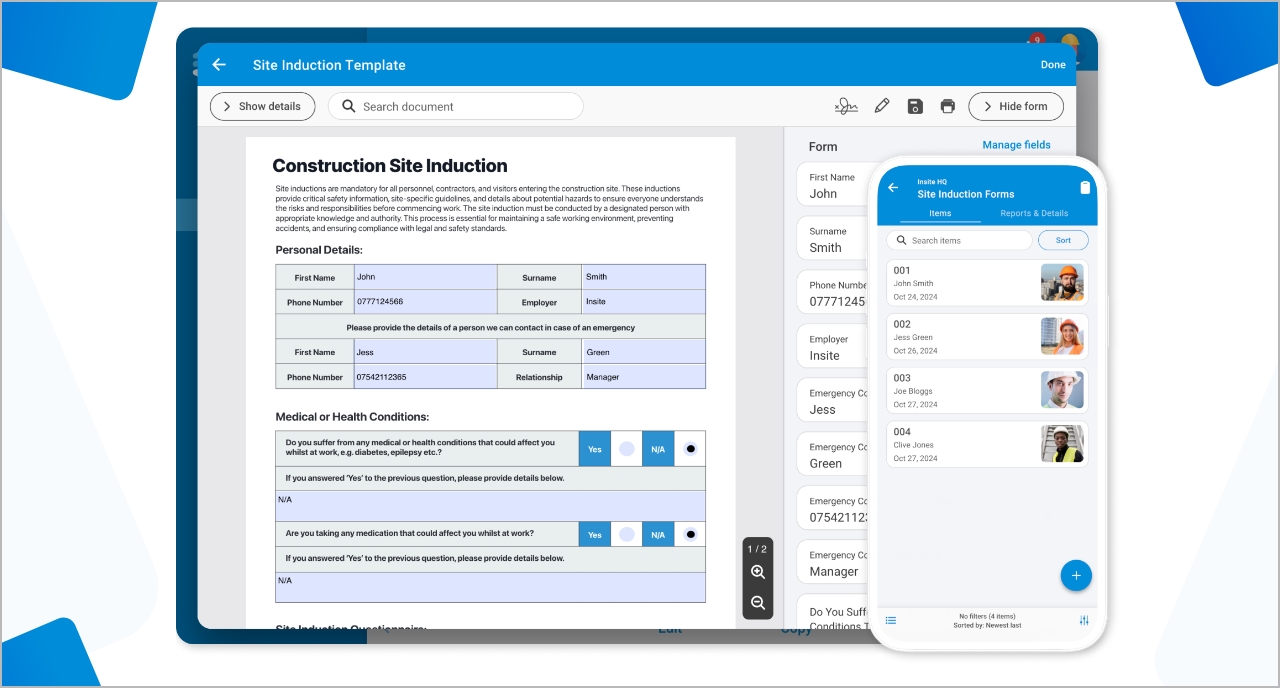Resources
Case studies
Videos
Sample reports
Free inspection templates
Learn
Blog
Product brochure
Training pack
Get the app
Download the app
Changelog
2024-10-24 | 4 min read
tags: Safety Free-Template Process Insite
Enhancing On-Site Safety with an effective Construction Site Induction Template

In the construction industry, ensuring that all workers, contractors, and visitors are familiar with site-specific safety protocols is not just a best practice - it’s a necessity. A well-designed Construction Site Induction Template plays a crucial role in keeping everyone on the same page, providing critical safety information, and helping to prevent accidents on-site.
Whether you are managing a small project or overseeing a large-scale construction site, having a structured induction process in place is essential for maintaining compliance with legal requirements and fostering a culture of safety.
In this post, we’ll explore how using an effective Construction Site Induction Template can improve safety, enhance productivity, and ensure every worker is prepared to face the unique challenges of your project.

Why a Construction Site Induction is Essential
Site inductions are a mandatory requirement in construction, ensuring that everyone entering the site is aware of the potential risks, the specific safety procedures, and the layout of the site. This process helps minimise risks by providing detailed guidance on what is expected of each individual.
Without a structured site induction, workers and visitors may overlook key safety protocols, leading to increased risks of accidents or non-compliance with safety regulations.
An effective Construction Site Induction Template ensures that no important details are missed and helps:
- Identify and communicate site-specific hazards: Every site has its own risks, and the induction template ensures these are clearly communicated to all.
- Outline key safety procedures: This includes personal protective equipment (PPE) requirements, safe access points, and emergency procedures.
- Ensure legal and regulatory compliance: Inductions are a legal requirement under most workplace health and safety regulations, and a good template ensures you meet these standards every time.

Key Components of a Construction Site Induction Template
An effective Construction Site Induction Template should cover all aspects of on-site safety and operations. Here are the key sections that should be included:
1. Site-Specific Hazards
Each construction site presents unique hazards, whether it’s heavy machinery, falling debris, or hazardous materials. A well-structured induction template ensures that all workers and visitors are made aware of these hazards before they step foot on-site.
2. PPE Requirements
The template should clearly outline the personal protective equipment required on the site. This could include hard hats, high-visibility clothing, steel-toed boots, and safety goggles, depending on the specific hazards of your site.
3. Emergency Procedures
An essential part of any induction process is ensuring that workers understand the emergency procedures, such as evacuation routes, muster points, and who to contact in case of an emergency. A comprehensive induction template will include this information to ensure everyone is prepared.
4. Site Access and Security Protocols
Detailing how workers and visitors can safely enter and exit the site, as well as any specific security measures in place, helps prevent unauthorised access and enhances overall site safety.
5. Roles and Responsibilities
It’s important for workers to know who is responsible for what on-site. This includes outlining key roles, such as the site manager, health and safety officers, and first-aid contacts, making sure all personnel know whom to report to with any concerns.

Benefits of Using a Construction Site Induction Template
The use of a Construction Site Induction Template can bring several benefits to your project:
- Consistency: Ensures that every person stepping onto the site receives the same level of information and safety training.
- Time-saving: Pre-structured templates save you time by providing a ready-to-use format for each new worker, contractor, or visitor.
- Compliance: Helps you meet all necessary health and safety regulations, reducing the risk of penalties or legal issues.
- Safety-focused culture: Promotes a culture where safety is always the top priority, leading to fewer accidents and incidents.

How to Implement an Effective Construction Site Induction
Here’s how you can make the most out of your Construction Site Induction Template:
- Customise for each site: While a template offers a standard structure, ensure it’s tailored to the specific needs of your site. Add or modify sections based on the particular hazards and requirements of your project.
- Involve your health and safety team: Collaborate with your health and safety officers to ensure the induction template covers all necessary aspects of compliance and risk mitigation.
- Ensure thorough communication: The induction process should be clear, concise, and interactive. Allow workers to ask questions to clarify any doubts about safety procedures.
- Regular updates: As the project evolves, so too will the risks and site-specific conditions. Regularly review and update your induction template to ensure it remains relevant.

Conclusion
A well-structured Construction Site Induction Template is an invaluable tool for improving safety, streamlining operations, and ensuring compliance on any construction project. By using a template that covers all necessary information - from site-specific hazards to emergency procedures - you can help protect your workforce and foster a safer working environment.
Download our free Construction Site Induction Template
Looking to improve your site safety and compliance? Download our free Construction Site Induction Template to ensure every worker is fully informed before starting work. Don’t wait - start safeguarding your construction site now!